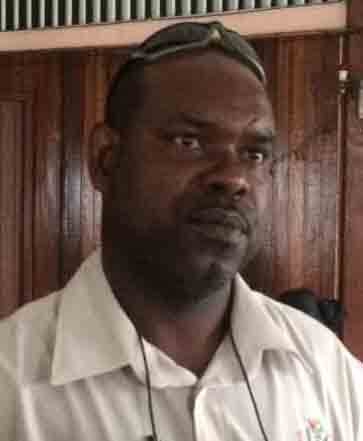The cleaning and sanitising of the Guyana Geology and Mines Commission (GGMC) and its environs, to rid the area of mercury residue, is expected to start before the end of the week, Head of the Guyana Civil Servants and General Workers Union (GCS&GWU) says.
Gregory Gaspar, giving an update on the situation regarding GGMC workers, who have boycotted the workplace in protest at the unsafe environment created at their Brickdam office as a result of high levels of mercury residue, explained that while work has not resumed, the Commission has made significant progress in procuring materials and chemicals for the cleanup.
Gaspar said that according to what has been relayed to him, the GGMC has so far been able to procure the specific chemicals that are needed for the cleanup, which he said is expected to start by the end of the week.
However, Gaspar could not give a timeframe for when the works are expected to be completed. “We are hoping that it can be better, but it’s not something that can be rushed because you have to ensure that it is removed properly and in a safe matter. We have no timeline set because outside and inside the buildings have to be properly cleaned and sanitized,” Gaspar noted.
The Ministry of Social Protection’s Department of Labour also made visits to the Guyana Gold Board’s (GGB) lab. Chairman of the Board, GHK Lall, when contacted on Wednesday, explained that there is a collaboration between different stakeholders to ensure that the cleanup is done efficiently.
While the lab and the burning of gold has been temporarily relocated, Lall said that they have not found a permanent location to relocate the lab but emphasized that the matter is engaging stakeholders at a “high level”, ministries and cabinet ministers included.
Lall noted that moving the lab to a permanent location is part of the GGB’s vision, adding that even though they are currently at a temporary location, their operations are running smoothly.
Despite some miners being aware of the temporary location, the Guyana Gold and Diamond Miners Association (GGDMA) related that they have not been formerly notified of the new arrangements.
“There’s a lot of people that don’t know where to do it and there has been no official communication. No press releases to the mining public. They have a representative on the board but in terms of official information, we don’t have any as yet,” a source from the GGDMA said.
The GGB and the Ministry of Natural Resources by extension, were forced to close the operations of the Gold Board’s lab, and stop the burning of gold, due to mounting pressure from the GGMC workers after high levels of mercury were found in the blood of a number of the employees.
A decision was made by the management of the Commission to boycott work and to continue doing so until the Gold Board’s lab had stopped its burning of amalgamated gold and a thorough cleanup was done.
During the course of the year, two employees died from kidney failure, cases which workers and the Union believe are linked to the high levels of mercury in the blood.
Their deaths are one of the main reasons that the employees and management decided to stay away from work.
According to the National Insurance Scheme, anything over the level of three microgrammes of mercury in the blood is considered as an industrial accident. According to some of the workers, most of the affected employees had levels of over five and some of them registered levels as high as 11.
Above normal levels of mercury can cause: mood swings, nervousness, irritability and other emotional changes, insomnia, headaches, abnormal sensations, muscle twitching, tremors, weakness, muscle atrophy and decreased cognitive functions.
Further exposure to mercury can also cause kidney malfunction and respiratory failure, which can both result in death.









